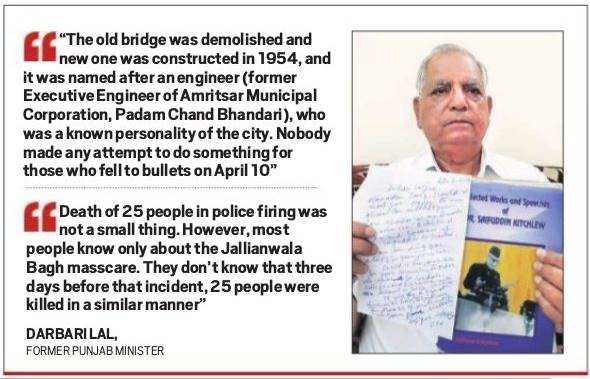Stay updated with the latest - Click here to follow us on Instagram
25 who fell to bullets on Bhandari bridge almost forgotten
The April 10 victims remained almost absent from public memory until 2009, when the record of Jallianwala Bagh tragedy was revisited.
 A view of Bhandari bridge, in Amritsar. (Express photo by Rana Simranjit Singh)
A view of Bhandari bridge, in Amritsar. (Express photo by Rana Simranjit Singh)
Three days before bullets rained on an unarmed crowd at the Jallianwala Bagh, 25 people were shot dead and several injured by the police on April 10, 1919 at a spot which is now known as the Bhandari bridge.
“I have taught them a lesson that they will never forget.” Those were the words of Amritsar police’s Assistant Deputy Superintendent R Ploomer, the officer behind the firing soon after the incident.
A 100 years later, it is the victims who stand forgotten. There is no memorial dedicated to these 25 citizens who were killed by British police during their attempt to cross the bridge to protest the arrest of local leaders Dr Satpal and Saffudin Kitchlew.
The April 10 victims remained almost absent from public memory, until in 2009, the record of Jallianwala Bagh tragedy was revisited after a letter from the Indian Council of Historical Research, New Delhi was sent to DC, Amritsar to find out authentic details of freedom fighters related to Jallianwala Bagh massacre.

“We were searching records of those days and we found reference to an FIR written in the Municipal Council register in Urdu and names of 11 people killed on April 10, 1919 were mentioned there. We translated it to English for the district administration,” said Parkash Singh Bhatti, ex-serviceman and known environmentalist.
According to book published in 1996 by the Punjab State University Textbook Board, Chandigarh and written by Dr Gursharan Singh and Dr Balraj Sagar, 25 people were killed during the incident.
The book adds that the crowd wanted to move towards the office of Deputy Commissioner on April 10 after news spread in the city that Dr Satpal and Kitchlew had been sent to the Dharamshala. They wanted to meet the Deputy Commissioner.
Then Deputy Commissioner Miles Irving reached the bridge which was then known by the names Hall Bridge, Lohe Wala Pul and Ucha Pul. He made an appeal to the crowd to disperse. The crowd was stopped by a wall of British soldiers and Amritsar police. Soon, fire was opened on the crowd and around 25 people were killed in this firing.
According to an eyewitness account in the book, Ploomer after the firing did not allow government medical staff to take the injured to hospital. Many injured were treated at the home of one Dr Mohammed Bashir with the help of assistant surgeon, Ishwardas Bhatia.
“We found only 11 names — 3 Muslims and rest Hindus, Sikhs — in the Municipal Council register, with reference to the original FIR. It is very normal that governments try to keep the number of deaths in such cases as low as possible and then British government must have did the same. More people would have died that day but they entered names of only 11 names,” said Bhatti.
Darbari Lal, a former minister, said: “Death of 25 people in police firing was not a small thing. However, most people know about Jallianwala Bagh but they don’t know that just before that incident, 25 people were killed in a similar manner.”
No special effort has been made to remember those victims on the 100th anniversary of the shooting. Also, the bridge that stood at the spot in 1919 was also demolished a few years back.
“The old bridge was demolished and new one was constructed in 1954, and it was named after an engineer (former Executive Engineer of Municipal Corporation, Amritsar, Padam Chand Bhandari), who was a known personality of the city. Nobody made any attempt to do something for those who fell to bullets on April 10,” said Darbari Lal.







